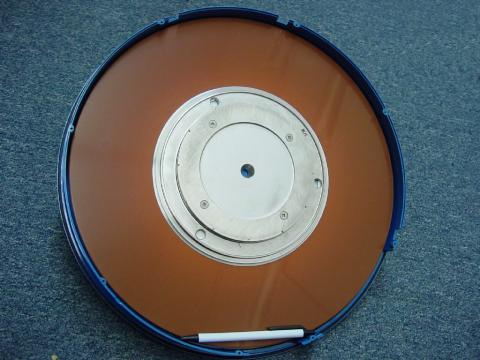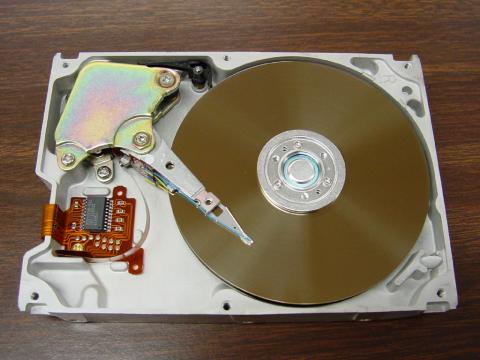The earliest forms of digital
data storage involving moving parts was that of the punched paper card.
Joseph Marie Jacquard invented a weaving loom in 1780 which automatically
followed weaving instructions set by carefully placed holes in paper cards.
This same technology was adapted to electronic computers in the 1950's, with
the cards being read mechanically (metal-to-metal contact through the
holes), pneumatically (air blown through the holes, the presence of a hole
sensed by air nozzle backpressure), or optically (light shining through the
holes).
An improvement over paper cards is the paper tape, still used in some
industrial environments (notably the CNC machine tool industry), where data
storage and speed demands are low and ruggedness is highly valued. Instead
of wood-fiber paper, mylar material is often used, with optical reading of
the tape being the most popular method.
Magnetic tape (very similar to audio or video cassette tape) was the next
logical improvement in storage media. It is still widely used today, as a
means to store "backup" data for archiving and emergency restoration for
other, faster methods of data storage. Like paper tape, magnetic tape is
sequential access, rather than random access. In early home computer
systems, regular audio cassette tape was used to store data in modulated
form, the binary 1's and 0's represented by different frequencies (similar
to FSK data communication). Access speed was terribly slow (if you were
reading ASCII text from the tape, you could almost keep up with the pace of
the letters appearing on the computer's screen!), but it was cheap and
fairly reliable.
Tape suffered the disadvantage of being sequential access. To address
this weak point, magnetic storage "drives" with disk- or drum-shaped media
were built. An electric motor provided constant-speed motion. A movable
read/write coil (also known as a "head") was provided which could be
positioned via servo-motors to various locations on the height of the drum
or the radius of the disk, giving access that is almost random (you might
still have to wait for the drum or disk to rotate to the proper position
once the read/write coil has reached the right location).
The disk shape lent itself best to portable media, and thus the floppy
disk was born. Floppy disks (so-called because the magnetic media is
thin and flexible) were originally made in 8-inch diameter formats. Later,
the 5-1/4 inch variety was introduced, which was made practical by advances
in media particle density. All things being equal, a larger disk has more
space upon which to write data. However, storage density can be improved by
making the little grains of iron-oxide material on the disk substrate
smaller. Today, the 3-1/2 inch floppy disk is the preeminent format, with a
capacity of 1.44 Mbytes (2.88 Mbytes on SCSI drives). Other portable drive
formats are becoming popular, with IoMega's 100 Mbyte "ZIP" and 1 Gbyte "JAZ"
disks appearing as original equipment on some personal computers.
Still, floppy drives have the disadvantage of being exposed to harsh
environments, being constantly removed from the drive mechanism which reads,
writes, and spins the media. The first disks were enclosed units, sealed
from all dust and other particulate matter, and were definitely not
portable. Keeping the media in an enclosed environment allowed engineers to
avoid dust altogether, as well as spurious magnetic fields. This, in turn,
allowed for much closer spacing between the head and the magnetic material,
resulting in a much tighter-focused magnetic field to write data to the
magnetic material.
The following photograph shows a hard disk drive "platter" of
approximately 30 Mbytes storage capacity. A ball-point pen has been set near
the bottom of the platter for size reference:

Modern disk drives use multiple platters made of hard material (hence the
name, "hard drive") with multiple read/write heads for every platter. The gap
between head and platter is much smaller than the diameter of a human hair.
If the hermetically-sealed environment inside a hard disk drive is
contaminated with outside air, the hard drive will be rendered useless. Dust
will lodge between the heads and the platters, causing damage to the surface
of the media.
Here is a hard drive with four platters, although the angle of the shot
only allows viewing of the top platter. This unit is complete with drive
motor, read/write heads, and associated electronics. It has a storage
capacity of 340 Mbytes, and is about the same length as the ball-point pen
shown in the previous photograph:

While it is inevitable that non-moving-part technology will replace
mechanical drives in the future, current state-of-the-art electromechanical
drives continue to rival "solid-state" nonvolatile memory devices in storage
density, and at a lower cost. In 1998, a 250 Mbyte hard drive was announced
that was approximately the size of a quarter (smaller than the metal platter
hub in the center of the last hard disk photograph)! In any case, storage
density and reliability will undoubtedly continue to improve.
An incentive for digital data storage technology advancement was the
advent of digitally encoded music. A joint venture between Sony and Phillips
resulted in the release of the "compact audio disk" (CD) to the public in
the late 1980's. This technology is a read-only type, the media being a thin
film of aluminum foil embedded in a transparent plastic disk. Binary bits
are "burned" into the aluminum as pits by a high-power laser. Data is read
by a low-power laser (the beam of which can be focused more precisely than
normal light) reflecting off the aluminum to a photocell receiver.
The advantages of CDs over magnetic tape are legion. Being digital, the
information is highly resistant to corruption. Being non-contact in
operation, there is no wear incurred through playing. Being optical, they
are immune to magnetic fields (which can easily corrupt data on magnetic
tape or disks). It is possible to purchase CD "burner" drives which contain
the high-power laser necessary to write to a blank disk.
Following on the heels of the music industry, the video entertainment
industry has leveraged the technology of optical storage with the
introduction of the Digital Video Disk, or DVD. Using a similar-sized
plastic disk as the music CD, a DVD employs closer spacing of pits to
achieve much greater storage density. This increased density allows
feature-length movies to be encoded on DVD media, complete with trivia
information about the movie, director's notes, and so on.
Much effort is being directed toward the development of practical
read/write optical disks (CD-W). Success has been found in using chemical
substances whose color may be changed through exposure to bright laser light,
then "read" by lower-intensity light. These optical disks are immediately
identified by their characteristically colored surfaces, as opposed to the
silver-colored underside of a standard CD. |